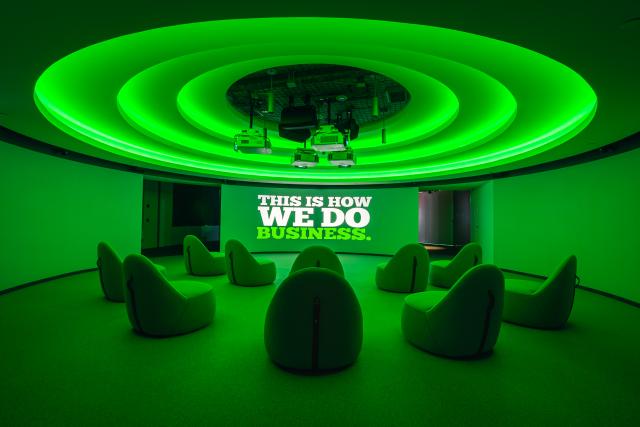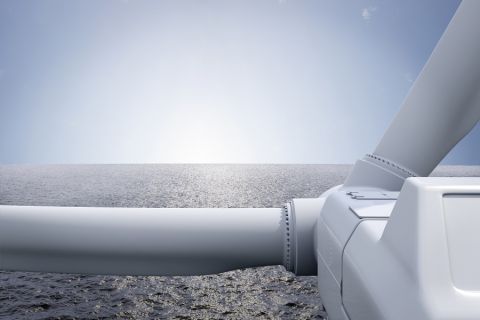
Co-located with Deloitte's downtown Houston office, this next-gen Deloitte Greenhouse will be the largest and the first of its kind to enable energy and industrials sector innovation through interactive spaces, collaborative technology tools and bespoke experiences that span the innovation life cycle. (Source: Francisco Perez/Cisco’s Studio)
As the oil and gas sector shifts to a low-carbon industry, archaic business models will have to transform as new energy challenges surface. To navigate the inevitable, Deloitte invested roughly $35 million to build a space that facilitates strategic conversations and controlled experimentation among energy companies.
“Everything is modular and can be changed depending on what the client wants to experience,” Katrina Drake-Hudson, strategic marketing lead at Deloitte, said. “We really worked hard on the science of helping a group make breakthroughs and get out of their usual engagement and standard discussions.”
Fittingly titled “Disneyland of the workplace,” the Deloitte Greenhouse lab creates immersive experiences to move leaders beyond traditional methods of problem-solving. The next-gen facility is based on the connected worker concept and provides business teams with interactive spaces, collaborative technology tools and bespoke experiences to inspire innovation.
By applying a demonstrated set of principles that combine behavioral science, analytics, technology and facilitation, executives are empowered to deviate from established methods of problem-solving to unlock new potential.
“The idea is that this space will let our clients come up with their own ideas,” she said. “They come to us with a challenge they want to get around from an energy transition perspective and we have the ability to facilitate them in a unique way. We bring our industry expertise of what’s happening in the industry as well as the technologies that will be transformative to their journey.”
Deloitte operates over 40 greenhouses globally, but the Houston lab is the largest and most advanced lab in its network of greenhouses. The unique lab houses a 360-degree immersion dome for projecting atmospheric and practical scenarios; 3-D printers; and breakthrough labs with large mounted screens powered by the operating system Prism.
“We wanted to create a more interactive and technologically enabled environment,” she said. “By creating an immersive environment, we’re letting teams physically experience transformative technology and move past the discussion phase into creating prototypes and ideation.”
The 14,000 sq ft greenhouse is divided into several interactive spaces, which were designed—unlike typical workspaces—to drive conversation and collaboration.
One quarter of the lab is dedicated to executive transitions. The company works with all c-suite roles to talk goals, budget and their action plan for the next 180 days of work. The company has helped over 5,000 executives across its network of greenhouses, she said.
“This pioneering next-gen Deloitte Greenhouse space brings together cutting-edge digital technologies and deep industry experience with human-centered experience design,” Kim Christfort, national managing director of The Deloitte Greenhouse Experience Group, said. “This powerful combination allows us to engage our clients and collaborators in fresh ways to shift mindsets, shed new light on complex challenges and create momentum for meaningful change. That’s what we call getting to breakthrough.”
When creating this lab—geared specifically to serve the energy sector—the company found collaborative and hands-on spaces help to shift mindsets and drive new energy innovation.
“Collaborative spaces is when people really break down their barriers and embrace change,” Amy Chronis, vice chair and managing partner at Deloitte, said. “It’s not enough to have your team just nodding their heads and not really committed to change.”
Chronis said this layout pushes leaders and their teams to be authentic and open-minded.
With the new energy frontier, this innovative workspace allows a typically reluctant industry to reimagine business as usual. However, she said the oil and gas industry is prepared and well-experienced in dealing with new challenges that disrupt the sector.
“People forget that this has been a frontier industry for decades,” Chronis said. “They forget how many transitions this industry has successfully made like going from leaded to unleaded fuel and shale being unpopular just 10 years ago. Carbon capture and storage wasn’t even on the agenda a few years ago. Now, everyone is talking about hydrogen and how Houston should be the hydrogen capital of the world.”
She said the journey to a low-carbon future is difficult and expensive, but “if any industry can figure out new horizons, it’s the energy business.”
Recommended Reading
Marketed: EnCore Permian Holdings 17 Asset Packages
2024-03-05 - EnCore Permian Holdings LP has retained EnergyNet for the sale of 17 asset packages available on EnergyNet's platform.
Marketed: Navigation Powder River Eight Leasehold Lots in Wyoming
2024-04-09 - Navigation Powder River has retained EnergyNet for the sale of eight non-producing federal leasehold lots in Converse and Campbell counties, Wyoming.
Exxon Signals Potential Counter Offer for Hess’ Guyana Assets
2024-03-07 - Exxon Mobil has filed a contract arbitration claim related to Chevron’s proposed purchase of Hess Corp.’s interests in the Stabroek Block offshore Guyana.
US Proposes Second GoM Wind Lease Auction
2024-03-20 - Combined, the four proposed areas for offshore wind have the potential to power about 1.2 million homes if developed, according to the Interior Department.
Marketed: Haynesville Shale 157 Well Package in Louisiana
2024-02-23 - A private seller has retained EnergyNet for the sale of a Haynesville Shale 157 well package opportunity in Bienville, Bossier, Casso, De Soto and Sabine parishes, Louisiana.

